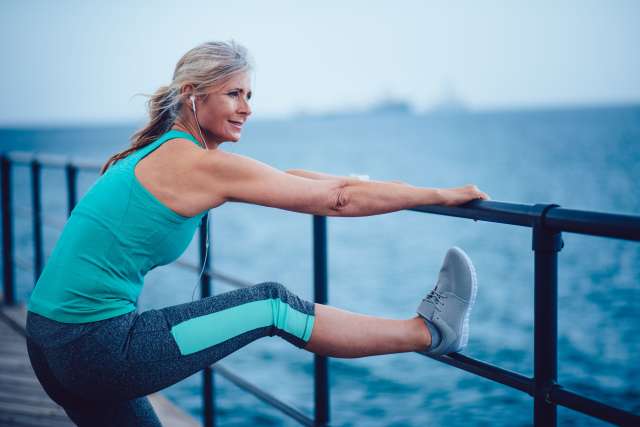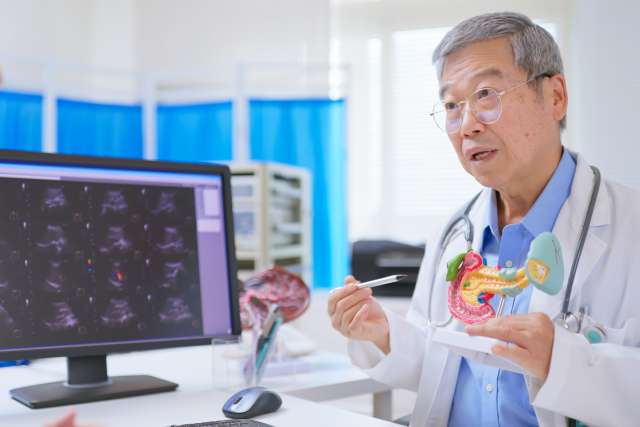Judith Gasson, senior associate dean for research in the Geffen School of Medicine, addresses an audience on campus before Julie Robinson, NASA's chief scientist for the International Space Station Program, speaks. Robinson met with UCLA scientists to learn about their research and inform them about opportunities to launch experiments into space. Photos by Reed Hutchinson |
What are the benefits of conducting scientific experiments at zero gravity? Who do you have to know to get your experiment on board the International Space Station? And just how much would that cost?
Julie Robinson, NASA's chief scientist for the International Space Station (ISS) Program, visited UCLA last Wednesday to talk to researchers about the potential for taking their experiments into space.
"When you take gravity out of the equation, you get an innovative platform," Robinson explained. "Every now and then, using an extreme laboratory can give you a way to poke a system and provide a real opportunity to make a breakthrough."
Already more than 1,500 investigations from scientists in 80 countries have been conducted since construction began on the space station 15 years ago, she said.
And the list of key discoveries made there covers a vast stretch of science: innovations in the delivery of cancer treatment; vaccine development for food poisoning and bacterial infections; a new medical device for wound healing; breakthroughs in water purification; and the development of the robotic neuroArm for performing complex surgeries inside an MRI machine.
As the most politically complex space exploration program ever undertaken, the space station is operated by an international partnership of government space agencies from the United States, Russia, Europe, Japan and Canada.
Cheryl Hein (left), managing director of the UCLA Center for Advanced Surgical and Interventional Technology, explains the research going on there to Robinson. The NASA scientist visited several campus labs. |
In 2005, Congress declared the U.S. portion of the International Space Station a national laboratory to "maximize its use as a unique research environment" for U.S. government agencies, academic institutions and the private sector. In 2011, a nonprofit entity, the Center for the Advancement of Science in Space (CASIS), was selected to manage the ISS National Laboratory, which, up until that time, had been run by NASA.
"Many people still think that to do research in space you have to go through NASA," Robinson said. "However, so much more can be done now because the International Space Station is a national laboratory. It opens up opportunities for institutions like UCLA to find partnerships in areas of their expertise and their mission that really intersect with what can be done in space."
The change means that researchers are no longer dependent upon NASA for funding, Robinson added. While NASA still determines about 50 percent of research projects that have space exploration as their core mission, the rest is now open to experiments that have benefits on Earth. For example, if NASA is not interested in a project, but a researcher has funding from another government agency or a corporation, the project could still be selected by CASIS. In addition, CASIS funds the operating costs for the lab, trains the astronauts to run the experiments and provides existing hardware.
So far, however, many scientists are not aware of these opportunities, Robinson said, calling the changeover a "quiet revolution." That's why she has been visiting with researchers across the country to spread the word and learn about potential collaborations. "The key is connecting with the right researchers that are on the cutting edge of their field."
At least one UCLA researcher has already had an experiment onboard the space station. In 2011, Vijay Dhir, dean of the UCLA Henry Samueli School of Engineering and Applied Science and a distinguished professor in mechanical and aerospace engineering, sent an experiment to the space station. Dhir's series of experiments were designed to develop a basic understanding of the heat-transfer and vapor-removal processes that take place during boiling under microgravity. Dhir is hoping to conduct follow-up research on upcoming missions.
"He doesn't need NASA funding anymore because the hardware is already there," Robinson said. "He can re-launch it with a new set of parameters. That's what CASIS is doing. We're supporting how you do research in space."
Dr. Benjamin Wu talks to Robinson about a bone density experiment that he is working on with a team from the Orthopaedic Hospital Center. |
Robinson said she was impressed by the broad multidisciplinary aspects of research at UCLA, and noted that the campus's physical layout was a plus in fostering collaboration among researchers in the life and physical sciences.
She visited with faculty members from the Orthopaedic Hospital Research Center, the California NanoSystems Institute, environment and sustainability, engineering, bioengineering, the Jonsson Comprehensive Cancer Center, the Broad Stem Cell Research Center, and the Center for Advanced Surgical and Interventional Technology.
"I did not realize that the International Space Station had the capabilities to do such a broad array of biomedical and biological science research," said Judith Gasson, senior associate dean for research in the David Geffen School of Medicine, whose office arranged the visit. "It opens up a whole new world of potential collaboration - in areas such as cancer, stem cells and tissue engineering - using zero gravity to better understand the interaction of molecules within the cells, and how the cells interact with each other."
Benjamin Wu, a professor with joint appointments in the engineering and dental schools and chair of the Department of Bioengineering, discussed a bone density experiment that he is working on in collaboration with colleagues from the Orthopaedic Hospital Center. The idea seemed such a good match that Robinson called a colleague at CASIS, and the three had an impromptu conversation about the possibility of getting the experiment aboard a future launch to the space station. Realizing that the cost of running the experiment might not be much greater than doing the work in his own lab, Wu said he is planning to talk more with CASIS.
"Conducting cutting-edge experiments at microgravity in the International Space Station is actually much more doable than I ever imagined," Wu said. "I didn't know that it was even feasible for non-space scientists."
Factoring gravity out as a variable allows for a cleaner interpretation of the underlying physics, Wu said. That ability would be beneficial to many bioengineering experiments, he said. And there is no way currently to simulate microgravity on Earth, Robinson said.
Without gravity, cells can take on completely different shapes and are not constrained by the forces of gravity. Already scientists have discovered that cellular differentiation at microgravity is slower. At UCLA's Broad Stem Cell Research Center, scientists are looking at embryonic stem cells and induced pluripotent cells to do a number of things, including creating tissue that can help repair diseased or degenerating organs.
"If the whole process could be slowed down, it might make it easier at a detailed level to study the molecular events that are going on during the differentiation process," Gasson said. "Understanding why could help us learn how to speed up the differentiation process, which might be used to more efficiently generate tissue for therapeutic uses."
Robinson said that the tissue grown on the International Space Station more closely resembles human tissue than if it grew in an earthbound laboratory. Further scientific study is needed to understand why.
The federal government recently announced ongoing funding support for the space station through 2024. For more information visit: www.iss-casis.org.
Marina Dundjerski



